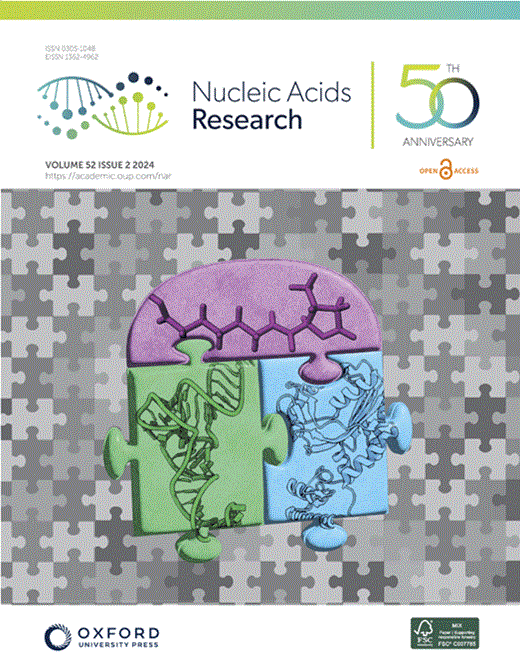dbPTM 2025 更新:全面整合 PTM 和蛋白质组数据,为癌症研究提供先进见解
IF 16.6
2区 生物学
Q1 BIOCHEMISTRY & MOLECULAR BIOLOGY
引用次数: 0
摘要
翻译后修饰(PTM)是调节蛋白质功能、影响稳定性、活性和信号转导过程的关键。dbPTM 2025 更新版大幅扩展了数据库,收录了 279 万多个 PTM 位点,其中 243 万多个位点经过了 48 个数据库和 8 万多篇研究文章的实验验证。该版本整合了 13 种癌症类型的蛋白质组数据,尤其侧重于磷酸蛋白质组数据和激酶活性图谱,从而可以探索肿瘤样本中的个性化磷酸化模式。dbPTM 2025 将激酶-底物磷酸化与 E3 连接酶-底物相互作用整合在一起,提供了 PTM 调控网络的详细地图,有助于深入了解癌症特有的翻译后调控。此次更新还包括高级搜索功能,使用户能够跨物种、PTM 类型和修饰残基有效地查询 PTM 数据。dbPTM 2025 还增强了功能注释、调控网络和疾病相关性,扩大了其在癌症研究和疾病相关 PTM 研究中的应用。通过这些改进,dbPTM 2025 成为一个全面、用户友好的资源,为研究 PTM 及其在癌症研究中的作用提供了便利。该数据库现在可在 https://biomics.lab.nycu.edu.tw/dbPTM/ 免费访问。本文章由计算机程序翻译,如有差异,请以英文原文为准。
dbPTM 2025 update: comprehensive integration of PTMs and proteomic data for advanced insights into cancer research
Post-translational modifications (PTMs) are essential for modulating protein function and influencing stability, activity and signaling processes. The dbPTM 2025 update significantly expands the database to include over 2.79 million PTM sites, of which 2.243 million are experimentally validated from 48 databases and over 80 000 research articles. This version integrates proteomic data from 13 cancer types, with a particular focus on phosphoproteomic data and kinase activity profiles, allowing the exploration of personalized phosphorylation patterns in tumor samples. Integrating kinase–substrate phosphorylations with E3 ligase–substrate interactions, dbPTM 2025 provides a detailed map of PTM regulatory networks, offering insights into cancer-specific post-translational regulations. This update also includes advanced search capabilities, enabling users to efficiently query PTM data across species, PTM types and modified residues. The platform’s new features—interactive visualization tools and streamlined data downloads—allow researchers to access and analyze PTM data easily. dbPTM 2025 also enhances functional annotations, regulatory networks and disease associations, broadening its application for cancer research and the study of disease-associated PTMs. Through these enhancements, dbPTM 2025 is a comprehensive, user-friendly resource, facilitating the study of PTMs and their roles in cancer research. The database is now freely accessible at https://biomics.lab.nycu.edu.tw/dbPTM/.
求助全文
通过发布文献求助,成功后即可免费获取论文全文。
去求助
来源期刊

Nucleic Acids Research
生物-生化与分子生物学
CiteScore
27.10
自引率
4.70%
发文量
1057
审稿时长
2 months
期刊介绍:
Nucleic Acids Research (NAR) is a scientific journal that publishes research on various aspects of nucleic acids and proteins involved in nucleic acid metabolism and interactions. It covers areas such as chemistry and synthetic biology, computational biology, gene regulation, chromatin and epigenetics, genome integrity, repair and replication, genomics, molecular biology, nucleic acid enzymes, RNA, and structural biology. The journal also includes a Survey and Summary section for brief reviews. Additionally, each year, the first issue is dedicated to biological databases, and an issue in July focuses on web-based software resources for the biological community. Nucleic Acids Research is indexed by several services including Abstracts on Hygiene and Communicable Diseases, Animal Breeding Abstracts, Agricultural Engineering Abstracts, Agbiotech News and Information, BIOSIS Previews, CAB Abstracts, and EMBASE.
 求助内容:
求助内容: 应助结果提醒方式:
应助结果提醒方式:


